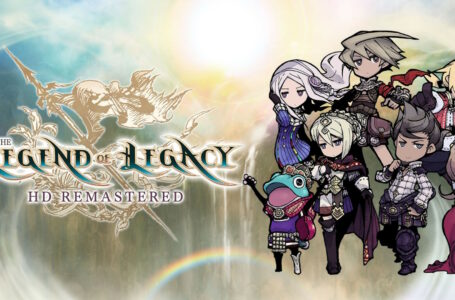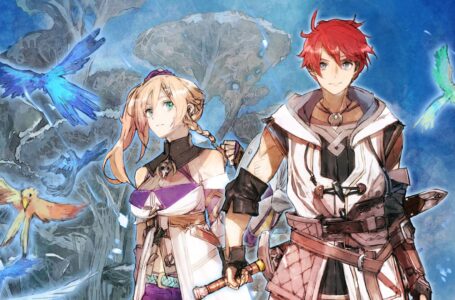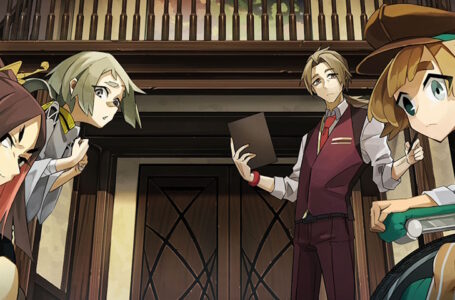Poison Control’s stylish shooting: B-tier Nippon Ichi at its best
One of my favourite discoveries in recent years is what I’ve come to think of as “B-tier Nippon Ichi Software” — and recent release Poison Control is a textbook example of this phenomenon.
In this instance, my use of the term “B-tier” isn’t pejorative — at least not in terms of the actual quality of the games. Rather, it refers to the fact that Nippon Ichi Software puts out a whole bunch of games each year that very few people end up talking about — be they press, public or indeed NIS themselves — and thus tend to end up being regarded as somehow less “important”, destined to end up on some YouTuber’s list of “5 Hidden Gems for Nintendo Switch” in 10 years’ time.
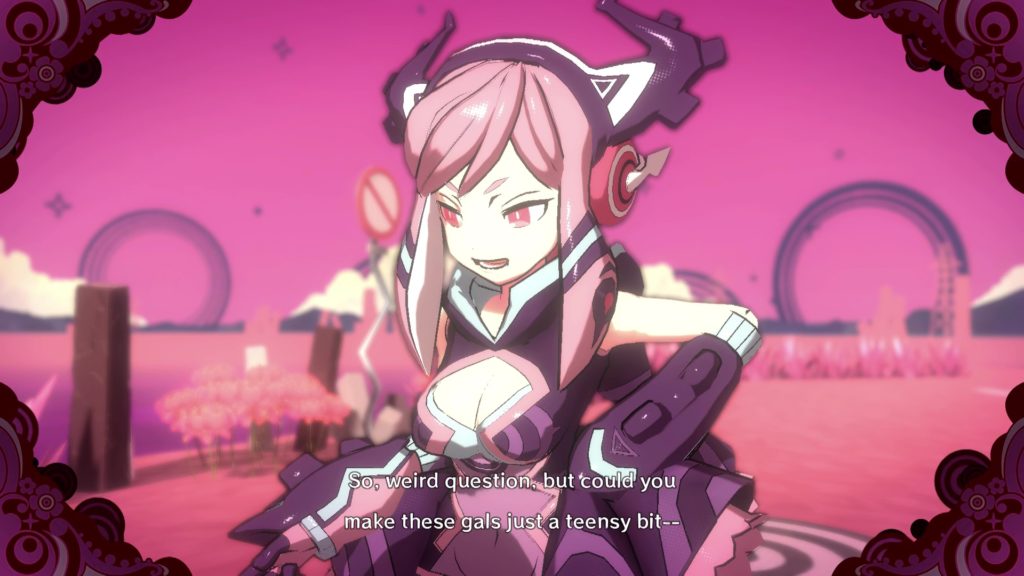
Everyone knows Nippon Ichi Software for its Disgaea series, which helped to popularise the strategy RPG subgenre in its early days, and has long been legendary for its wealth of playable content, in-depth progression systems and brilliantly written characters. But NIS is much more than just Disgaea. Much more. Disgaea just gets the majority of the attention for one reason or another.
B-tier Nippon Ichi games tend to have a number of things in common: a willingness to experiment with mechanics and unconventional genre combinations; beautiful presentation despite budget limitations; the same witty writing the Disgaea series is known for; and that same long-term appeal that Disgaea has. So it’s kind of baffling to me that great games from over the years like Battle Princess of Arcadias, Legasista, Penny-Punching Princess, The Princess Guide, Lapis x Labyrinth, Mad Rat Dead and now Poison Control haven’t had more love over the years — because they most certainly deserve it.
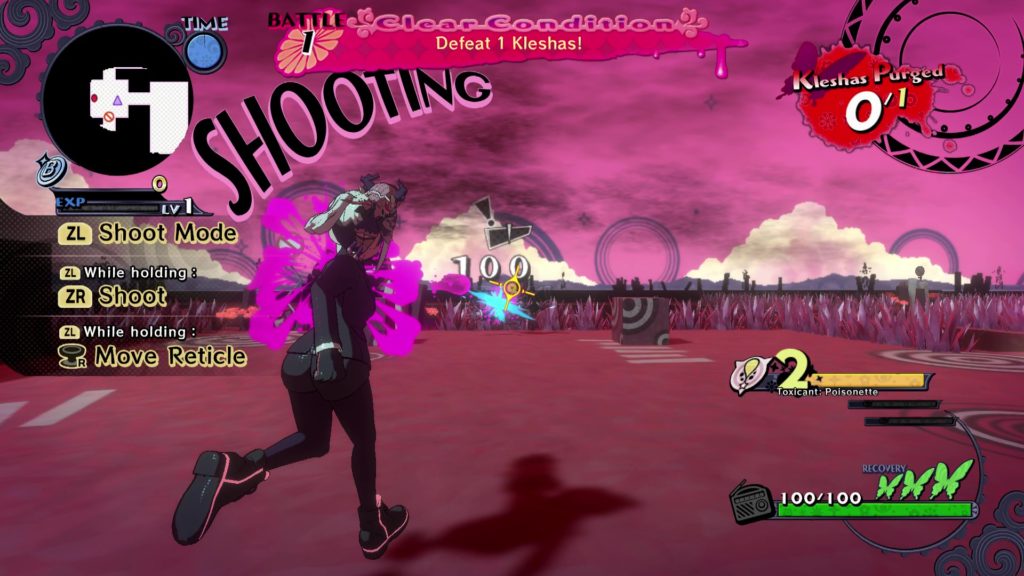
So let’s do our part right now and take a nice long look at the early hours of Poison Control, which released digitally in mid-April, and whose physical editions are now getting into the hands of those who ordered them directly from NIS America and NISA Europe. We’ll then return to the game a bit later to see how it holds up over the long term!
In Poison Control, you take on control of a lost soul who finds themselves in Hell. It’s not long before you’re attacked by a strange creature known as a Klesha, who sucks off all your skin and takes partial possession of your body, at which point she reveals herself to be a spunky young girl who can’t remember her own name. From this point on, it seems, she is your “Soul Mate”, sharing your body and allowing you to make use of her abilities to clear the poison mires of Hell, saving the “Hell’s Belles” from their torment in the process.
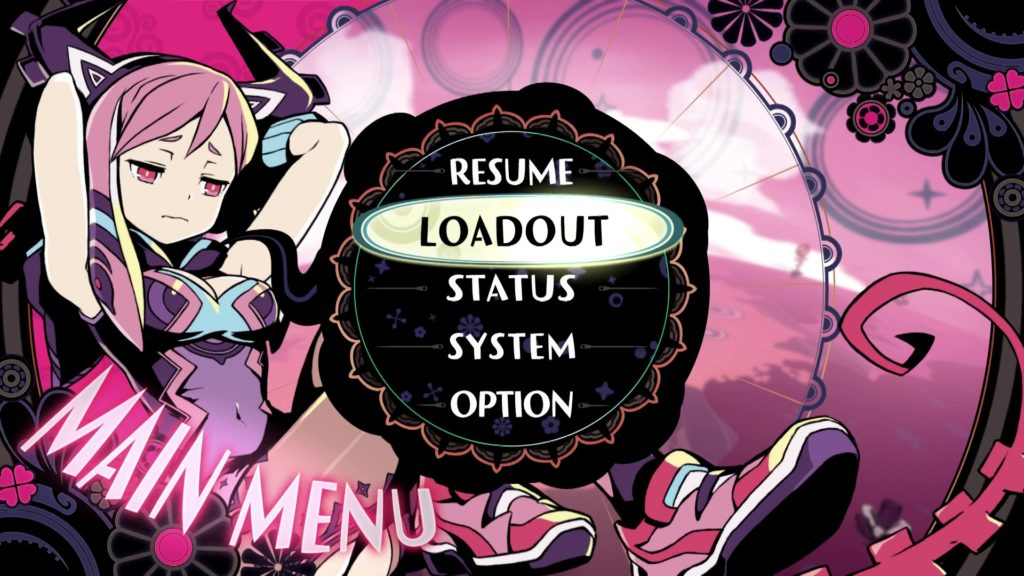
Why should you help her? Well, because if you earn enough special tickets by getting to the bottom of the various issues the Hell’s Belles have, both you and Poisonette, as your new friend takes to calling herself, will be able to ascend to Heaven. But you need to hurry, because you’re not the only one after those tickets — and there’s only room for one (plus a ridealong Soul Mate) on the trip upstairs.
What unfolds from thereon in Poison Control is a series of missions in which you take control of your character — whom you can name, select the gender of and pick a voice for at the outset of the game — as they work alongside Poisonette to clear each of the missions they’re presented with. Each mission unfolds as a self-contained dungeon which generally has a main objective to accomplish in order to clear, but also plays host to collectible items that enable you to unlock new equipment.
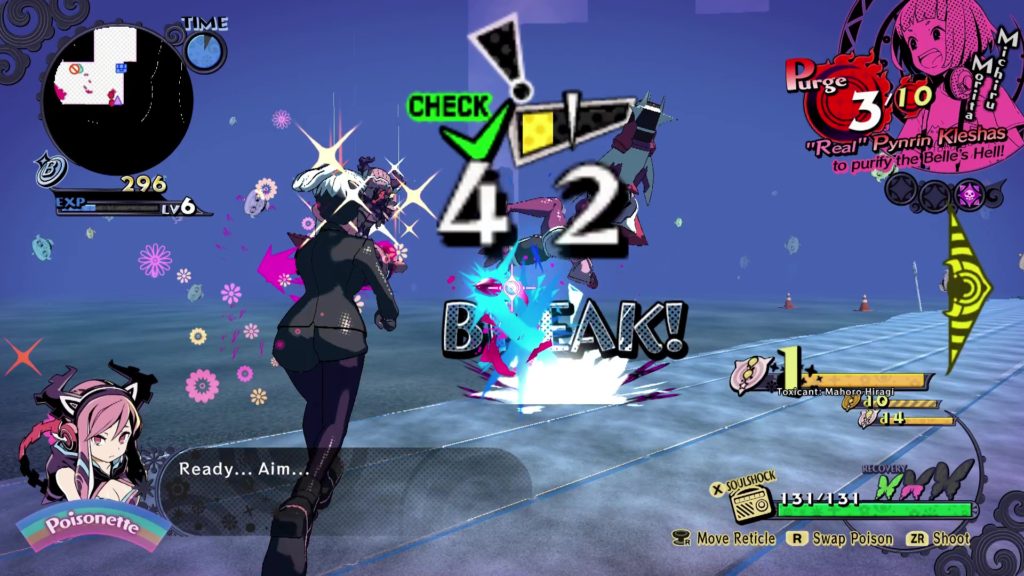
You’ll be spending most of your time doing two things in Poison Control: fighting off enemies with the game’s third-person shooter mechanics, and clearing poison mires using Poisonette’s abilities.
In the former case, squeezing the left trigger puts you into Aim Mode, which allows you to fire with the right trigger. You can also lock on to enemies, and there are several levels of aim assist available to help you out.
When fighting enemies, Poison Control makes use of a “Break” system similar to that found in Penny-Punching Princess, in that knocking a foe’s hit points down to a certain mark on their health gauge will temporarily stagger them. Some enemies also have glowing “cores” on them that can be destroyed to cause another Break; when battling more powerful enemies and bosses, picking off these targets can make combat much easier to deal with.
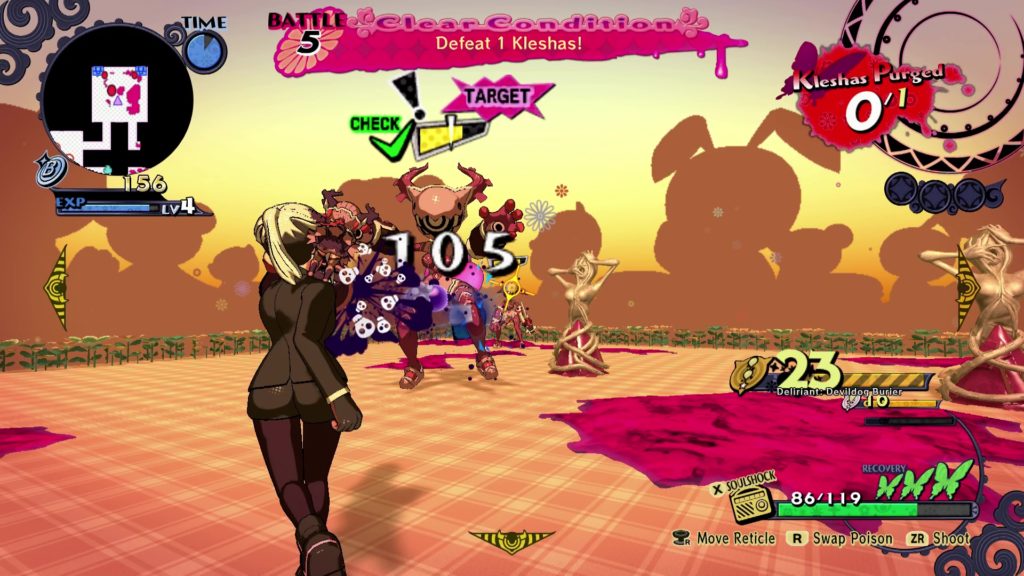
Rather than providing non-stop, relentless action, Poison Control places a strong emphasis on ammo management. You initially begin with nothing more than Poisonette’s ability to fire basic shots, and when she’s exhausted, she takes a few seconds to recharge and fill up again.
As you progress, you’ll find additional weapons; Toxicants will automatically reload when empty like Poisonette does, while Deliriants are single-use weapons that you’re done with once you’ve exhausted them. Deliriants are often found as random loot around the stages, while Toxicants (along with the armor and accessory equivalents Antidotes and Catalysts) are unlocked by finding the three hidden items in each of the Belles’ Hells.
The limited ammunition means that you’ll need to fight quite carefully; it’s not quite survival horror-tier “only shoot if you need to”, but you will need to stay on the move while you reload quite often — which brings us to the poison-clearing side of things from which Poison Control takes its name.
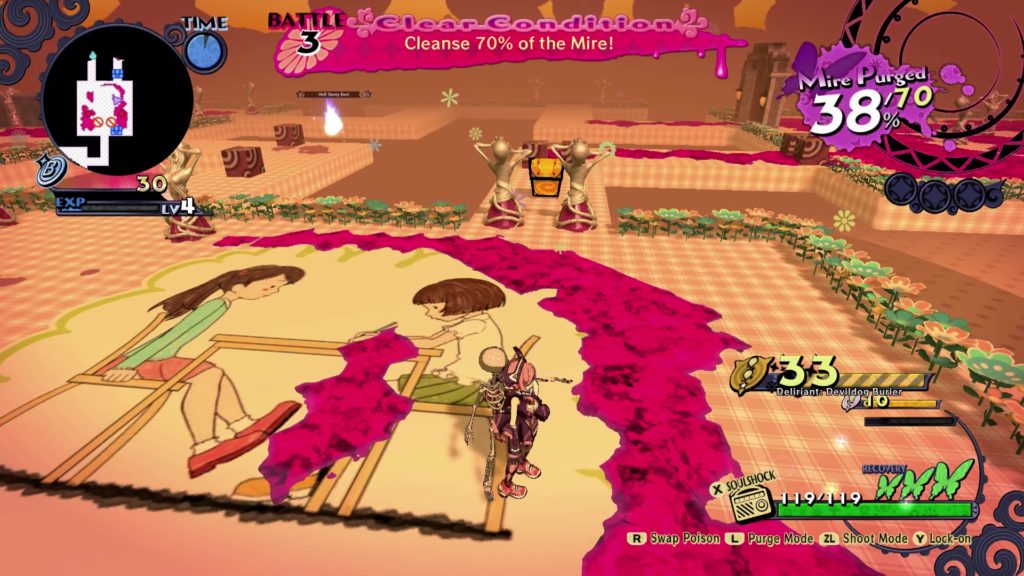
By holding the left bumper, you’ll temporarily shed your skin and let Poisonette out, who is then able to run around for a short period, marking an area to “purge” with a dotted trail she leaves behind herself. By running over poison mires with Poisonette, you can clear them, reveal the items that may be hidden (which can include ammunition), heal yourself and damage any enemies who happen to be standing in them when you purge them.
You can even clear larger areas if you completely encircle them with Poisonette’s trail, meaning you don’t need to run over every spot of a large mire — indeed, the limited time Poisonette is able to operate independently of you means that this technique is essential to master.
Purging poison mires also helps to refill a “Recovery” meter in the corner of the screen that essentially acts as a stock of lives; run out of HP and you’ll lose one of the three glowing “butterflies” on the meter and fill yourself back up to full immediately. Run out completely and you’ll fail the mission.
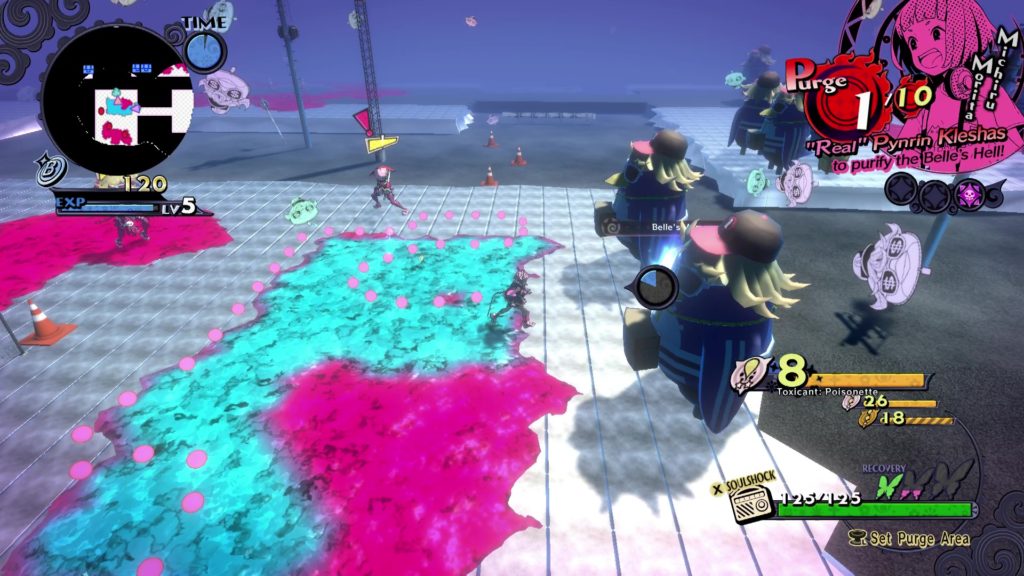
Poison Control’s recovery meter does not restock between missions, meaning you’ll need to keep purging poison mires in order to top it back up again; this is generally pretty straightforward to do, but the truly lazy can also buy an 89p microtransaction to immediately refill it and temporarily raise its maximum to four respawns. Don’t do this; there’s really no need for it from a mechanical perspective as the meter is easy enough to refill yourself, and we shouldn’t be encouraging this sort of thing either. Thankfully, the whole system is unobtrusive and easy to ignore.
As you progress through each mission in Poison Control, you’ll encounter various spirits who help to tell the story of the particular Hell’s Belle you are exploring the personal Hell of at the time. And at various junctures, you’ll stumble across key items, which trigger a Heart-to-Heart conversation between you and Poisonette; your responses to her statements and questions build up various personality statistics, with passive bonuses on offer at various level milestones for each stat.
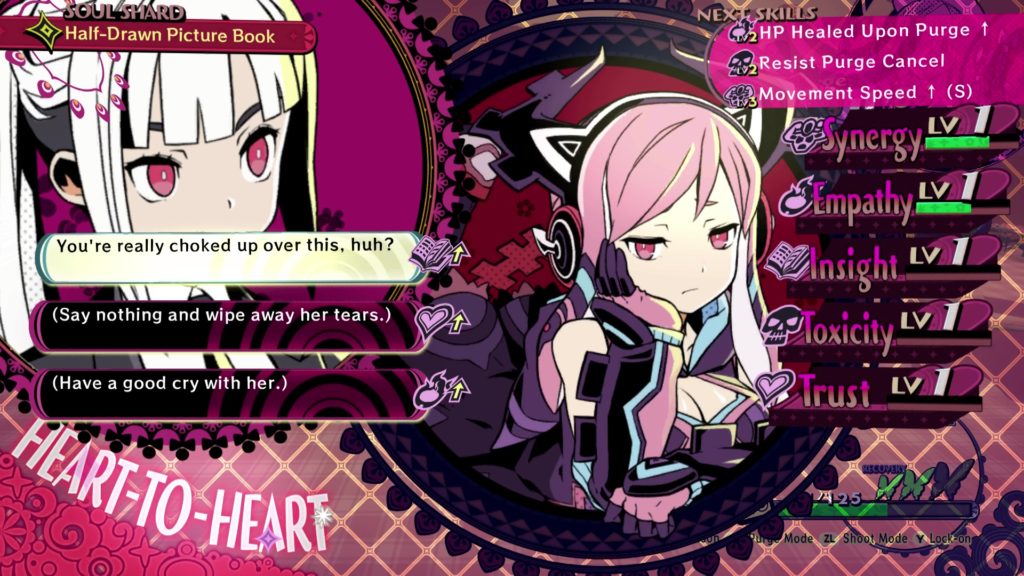
Ultimately your aim in each mission is to help the Hell’s Belle make peace with whatever brought them to Hell in the first place. In some cases, the Hell’s Belle is a living person who is at risk of falling into darkness after a particularly traumatic incident in their lives; in others, they are someone who has already passed on, but who is unable to reach Heaven due to their regret or anger.
The game actually deals with some fairly heavy subject matter right from its very outset, including a girl who feels a lingering sense of regret over being murdered before she was able to share the final picture book she’d been working on with her friend; a child who, unable to deal with the grief from her dog dying, takes to killing animals in an attempt to “fill up Heaven” so her dog can “come back”; and a girl who, unable to cope with the stresses of her life, thinks that “erasing” her worries by burning them is a sustainable way to live.
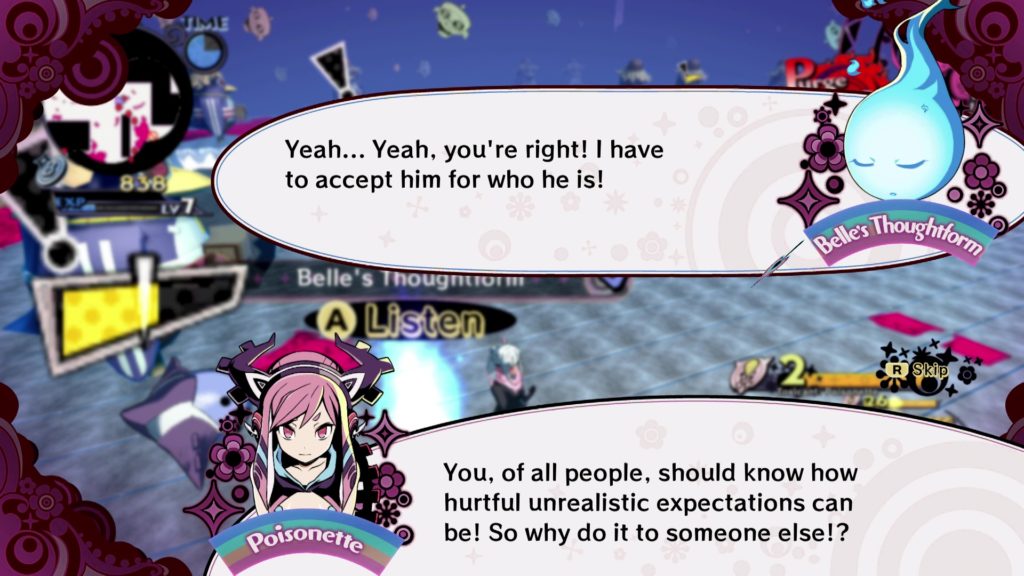
While each of these episodes unfolds over the course of a relatively short space of time, they manage to be by turns tragic, thought-provoking and heartwarming. And at no point are your character and Poisonette implied to be “fixing” the Belles completely; instead, their intervention helps the Belles to look at the situation from another angle, think about things a bit more carefully and perhaps consider how their actions are affecting others. Those who enjoyed Gust’s approach to mental health-related subject matter in Blue Reflection will be right at home here.
Don’t assume it’s all bleakness, though. As with every other Nippon Ichi game out there, Poison Control is tied together with a sense of wit and charm that doesn’t undermine the more serious messages the narrative has to deliver, but simultaneously reminds us that it’s okay to inject a sense of levity into the proceedings at times. And indeed, levity is sometimes a helpful coping mechanism when presented with situations that are otherwise difficult to deal with.
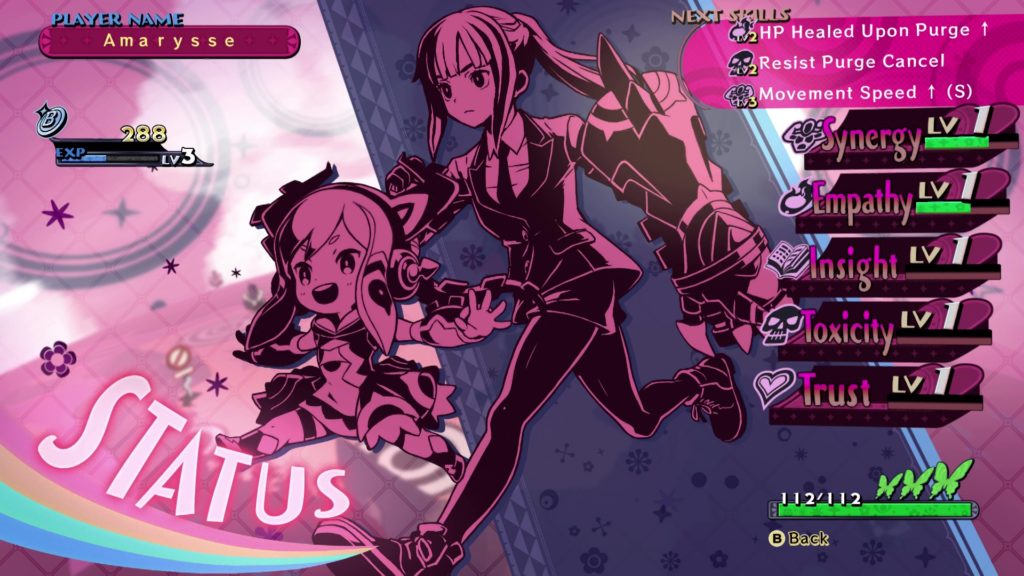
Poison Control plays well and has a compelling narrative, but the real highlight of the experience is the outstanding sense of style the whole experience has. Deliberately making use of high-contrast artwork with a limited colour palette and comic book-style halftones, Poison Control makes an immediately striking impression with the way it looks, and continues to impress with every new menu screen and event scene that shows up.
Likewise, while the 3D visuals of the actual gameplay perhaps aren’t the most technically impressive you’ll ever see, they make the same use of striking, contrasting colours as the 2D art coupled with some excellent animation and, most importantly for a real-time action game, never feel like they’re getting in the way or obscuring things.
Alongside the gorgeous visuals, we have a wonderful soundtrack that blends a variety of different styles, from driving rock rhythms to ’80s-inspired synthwave. Different Belles’ Hells have different musical themes that fit the overall tone of the stories you uncover, while the oddly cheerful and optimistic view of Hell that the game offers outside of missions is highlighted with some catchy, poppy tunes that fit Poisonette’s personality in particular very well.
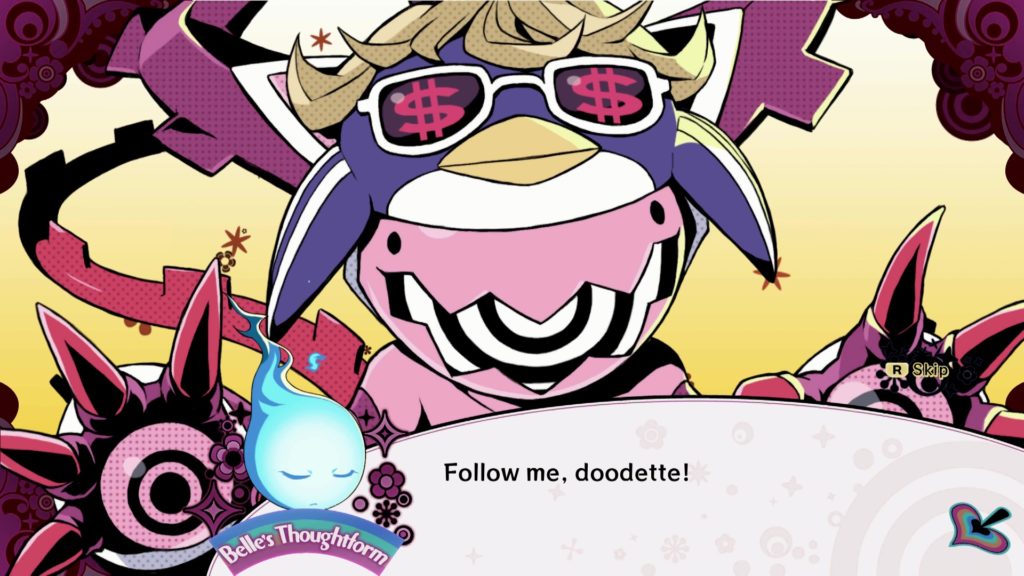
The whole thing is a consistent delight to both look at and listen to — and this side of things in particular is one of the reasons I’m so surprised the game hasn’t enjoyed more buzz online since its release, since as you can hopefully see from the images on this page, it sure takes a nice screenshot!
Ah well. All we can do in situations like this is spread the good word as much as we can, so consider this our contribution to the cause. Poison Control is worth your time — and we’ll be back to explore it in more detail soon!
Join The Discussion
Rice Digital Discord
Rice Digital Twitter
Rice Digital Facebook
Or write us a letter for the Rice Digital Friday Letters Page by clicking here!
Disclosure: Some links in this article may be affiliate links, which means we may earn a small commission if you make a purchase after clicking on them. This is at no additional cost to you and helps support Rice Digital!
- Letter from the Editor: passing the torch - June 30, 2023
- Super Woden GP 2 is looking promising - June 30, 2023
- Inti Creates is making a 32 bit-style Love Live action platformer - June 26, 2023




